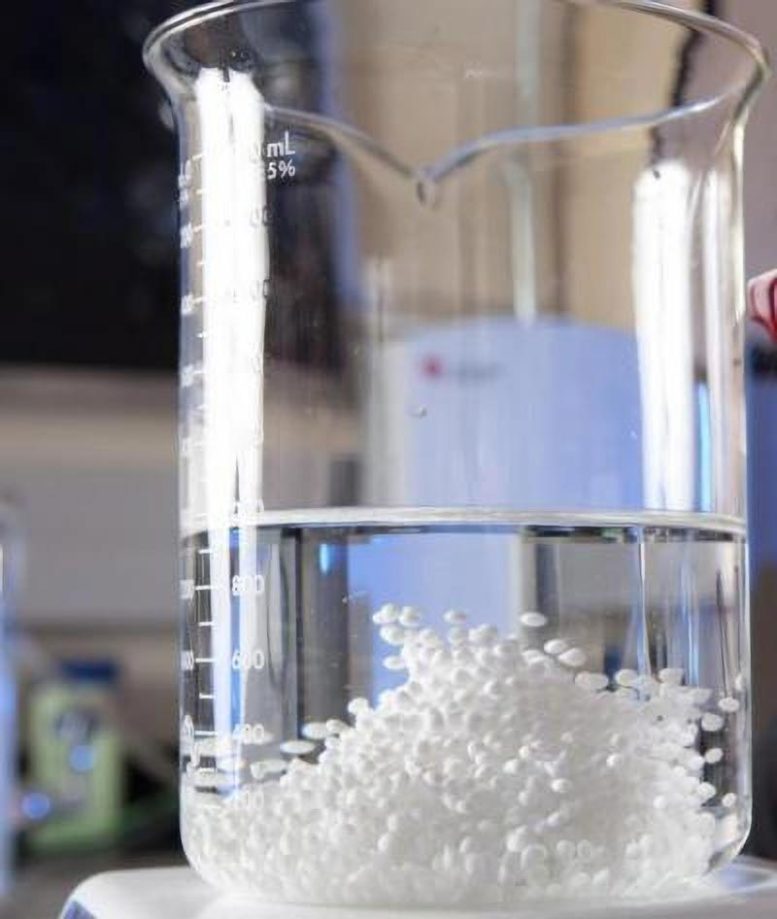
The Zimmerman lab developed chitosan beads impregnated with titanium dioxide and aluminum oxide. These beads are used for the removal of heavy toxic metals, like arsenic and selenium, from water. Credit: Harold Shapiro
By turning chitosan into beads and impregnating them with nanoparticles of titanium dioxide and aluminum oxide, scientists developed a technique that removes both arsenite and arsenate with the same efficacy as the nanopowders, but without the post-treatment filtration requirements.
Inorganic arsenic, which can contaminate water supplies via runoff from industrial manufacturing and mining processes, is known to cause cancer and death in humans as well as disruption in biological ecosystems. Several approaches have been used to remove arsenic from water in the laboratory, but most have proved to be inadequate for wide-scale use, and especially for sustainable implementations. Now, researchers at Yale University have developed a novel approach that can remove arsenic from water with high efficacy, and has the potential to be implemented sustainably.
Researchers have previously used aluminum oxide and titanium dioxide in nanopowder form to remove two forms of arsenic, arsenite, and arsenate, from water. But, says Julie Zimmerman, Associate Professor of Chemical & Environmental Engineering & Forestry & Environmental Studies, “The use of nanopowders requires post-treatment filtration, which can be energy intensive.”
To address that limitation, Zimmerman and her colleagues developed a system using chitosan, a biopolymer derived from shellfish exoskeletons. Chitosan is an abundant waste product that’s readily available; by forming it into beads and impregnating them with nanoparticles of titanium dioxide and aluminum oxide, the researchers developed a sustainable technique that removes both arsenite and arsenate with the same efficacy as the nanopowders, but without the post-treatment filtration requirements. Further, by using titanium dioxide and aluminum oxide in combination, significant synergies are realized.
“When titanium dioxide is exposed to ultraviolet light it generates hydroxyl radicals,” explains Zimmerman. These are very effective oxidizers that react with arsenite, the more toxic of the two arsenic types, to transform it to arsenate. The arsenate then sorbs to the aluminum oxide, effectively removing it from the drinking water.
“One of the things we try to do broadly is to design systems to inherently have desirable characteristics, rather than continually needing to control the circumstances,” says Zimmerman. “For example, the chitosan beads separate by density, so we don’t need to add any additional energy or materials to separate the purified drinking water from the arsenic-laden sorbent.” The beads can then be regenerated by washing them with a slightly basic solution to remove the sorbed arsenic, and re-used without any noticeable decrease in performance for at least five cycles.
In addition to arsenic removal, Zimmerman notes that the chitosan bead technique has further potential applications in the treatment of water supplies.
“There are lots of other metal contamination issues in aqueous systems that are appropriate for this type of system, making it a platform technology. For example, we’re completing a study on selenium, which is of interest since there is recent activity by the Environmental Protection Agency in setting new water quality criteria limits,” she explains. “We can dope this system with nanopowders or other potential sorbents that are specifically targeted to the contaminant or contaminant mixtures of concern. Further, chitosan, itself, has been shown to be effective at removing certain aqueous contaminants. In this way, the chitosan can be an active, not passive, impregnation matrix.”
Reference: “Enhanced arsenic removal using mixed metal oxide impregnated chitosan beads” by Jamila S. Yamani, Sarah M. Miller, Matthew L. Spaulding and Julie B. Zimmerman, 15 June 2012, Water Research.
DOI: 10.1016/j.watres.2012.06.004








in water filtration systems to bind sediments together and make them easier to remove has been one of the many uses of chitosan. It comes in three main forms, but may have several different types, depending on the crustaceans used to create the supplement.
A lot of nanostructured materials has been successfully employed in various multidisciplinary fields, expectation’s arises that the integration of nanotechnology and natural polymer chemistry will lead to further innovative applications for environment and medicine.